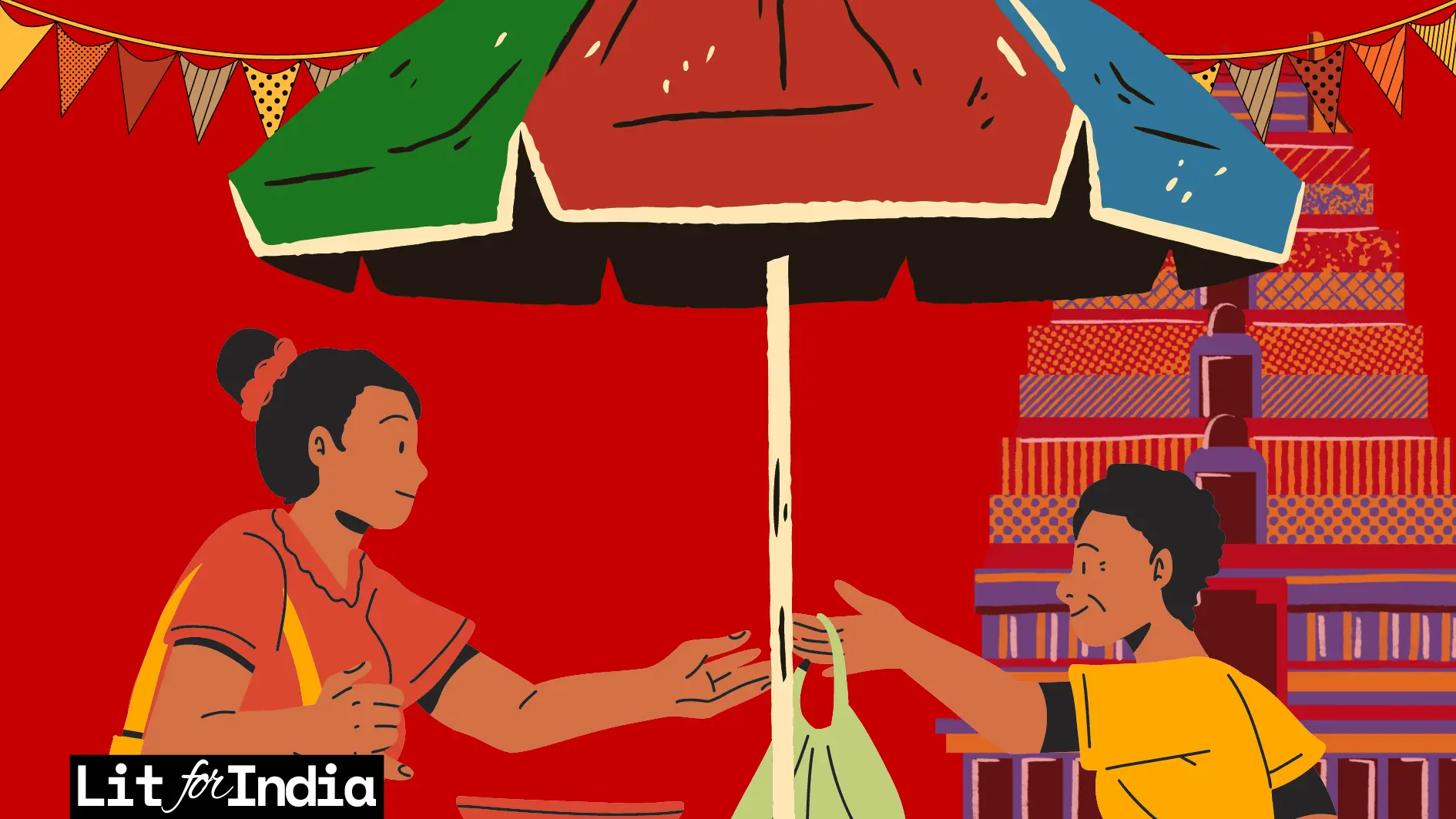Bangle Sellers by Sarojini Naidu is a captivating poem that showcases the literary prowess of this renowned Indian poet. Sarojini Naidu, often referred to as the “Nightingale of India,” has left an indelible mark on the world of poetry with her enchanting verses. In this blog, we will delve into the depths of this poem, providing an extended summary and an in-depth analysis of this timeless work. Through our exploration, we aim to uncover the hidden meanings and underlying themes that make Bangle Sellers by Sarojini Naidu a true masterpiece in the realm of Indian literature.

Table of Contents
Bangle Sellers by Sarojini Naidu
Stanza 1
Bangle sellers are we who bear
Our shining loads to the temple fair…
Who will buy these delicate, bright
Rainbow-tinted circles of light?
Lustrous tokens of radiant lives,
For happy daughters and happy wives.
Stanza 2
Some are meet for a maiden’s wrist,
Silver and blue as the mountain mist,
Some are flushed like the buds that dream
On the tranquil brow of a woodland stream,
Some are aglow wth the bloom that cleaves
To the limpid glory of new born leaves
Stanza 3
Some are like fields of sunlit corn,
Meet for a bride on her bridal morn,
Some, like the flame of her marriage fire,
Or, rich with the hue of her heart’s desire,
Tinkling, luminous, tender, and clear,
Like her bridal laughter and bridal tear.
Stanza 4
Some are purple and gold flecked grey
For she who has journeyed through life midway,
Whose hands have cherished, whose love has blest,
And cradled fair sons on her faithful breast,
And serves her household in fruitful pride,
And worships the gods at her husband’s side.
Summary of Bangle Sellers
Here’s a detailed, stanza-wise summary of “Bangle Sellers” by Sarojini Naidu:
Stanza 1
The poem begins with the bangle sellers calling out to potential buyers at a temple fair. They describe their bangles as “lustrous tokens of radiant lives.” The bangles are not just ornamental; they represent the joys, traditions, and duties of Indian women. The sellers emphasise that their bangles are sacred and suitable for various life stages and ceremonies. This stanza sets the scene of a lively, traditional marketplace filled with cultural vibrancy.
Stanza 2
In this stanza, the focus shifts to bangles that are ideal for young maidens. These bangles are compared to “new-born leaves” and “silver and blue mountain mist,” highlighting their delicate beauty and freshness. They symbolise the innocence, purity, and youthful aspirations of unmarried girls. The colours represent the dreams and hopes of young women, poised on the brink of adulthood, filled with anticipation and excitement about their future.

Stanza 3
This stanza describes the bangles that are perfect for brides. The bangles are “shining loads” that reflect “bridal laughter and bridal tear,” capturing the emotional spectrum of a bride on her wedding day. They are described as rich hues of yellow and fiery red, symbolizing the sanctity and fervour of marriage. These bangles signify the auspiciousness of the wedding and the bride’s entry into a new phase of life, marked by love, joy, and traditional rituals.
Stanza 4
The final stanza speaks of bangles for middle-aged women, who have journeyed through marriage and motherhood. The bangles are “purple and gold-flecked gray,” symbolizing the dignity and wisdom that come with age. These colors represent a blend of life’s experiences, encompassing the pride and contentment of a woman who has successfully raised her children and managed her household. The bangles reflect her maturity, serenity, and fulfillment, celebrating her life’s accomplishments and the depth of her inner strength.
Sarojini Naidu’s “Bangle Sellers” beautifully captures the essence of Indian womanhood through the metaphor of bangles, reflecting the cultural and emotional milestones of their lives. The poem not only showcases the significance of bangles but also honours the various roles and stages women go through, celebrating their beauty, strength, and resilience.
Analysis of Bangle Sellers
Stanza 1: Introduction and Setting
The poem begins with the bangle sellers inviting people to buy their bangles. The opening lines, “Bangle sellers are we who bear / Our shining loads to the temple fair,” immediately set the scene of a bustling, colourful marketplace. The reference to the temple fair indicates a setting steeped in tradition and cultural significance. The bangles are described as “lustrous tokens of radiant lives,” highlighting their importance not just as ornaments, but as symbols of various milestones and emotions in a woman’s life. This stanza establishes the idea that bangles are integral to the cultural and spiritual fabric of Indian society.
Stanza 2: Bangles for Maidens
The second stanza focuses on bangles suited for young, unmarried girls. The imagery used here is delicate and fresh, comparing the bangles to “new-born leaves” and “silver and blue mountain mist.” These comparisons evoke a sense of purity, innocence, and the natural beauty of youth. The colours and descriptions reflect the dreams, aspirations, and youthful energy of maidens who are yet to embark on the journey of marriage. This stanza captures the essence of youthful potential and the anticipation of future possibilities.
Stanza 3: Bangles for Brides
In the third stanza, the poet shifts to the description of bangles appropriate for brides. These bangles are “shining loads” that embody “bridal laughter and bridal tear,” signifying the mixed emotions a bride experiences. The colors, described as rich yellow and fiery red, are traditionally associated with weddings and symbolize prosperity, sanctity, and passionate love. This stanza encapsulates the joy, excitement, and sacredness of the wedding ceremony, as well as the transformative nature of marriage in a woman’s life. It celebrates the bride’s transition from maidenhood to womanhood and the cultural importance of this rite of passage.
Stanza 4: Bangles for Mature Women

The final stanza addresses the bangles worn by middle-aged women who have experienced the fullness of life. The bangles are “purple and gold-flecked gray,” colors that suggest maturity, dignity, and wisdom. This imagery reflects the depth and complexity of a woman’s life after she has navigated the responsibilities of marriage and motherhood. The purple symbolizes pride and achievement, while the gold-flecked gray denotes the grace and serenity that come with age. This stanza honors the resilience, fulfillment, and contentment of women who have fulfilled their roles as caregivers and nurturers, celebrating their enduring strength and inner beauty.
Themes and Symbols
Tradition and Culture: The poem deeply resonates with Indian cultural traditions, particularly the significance of bangles in a woman’s life. Bangles are not mere accessories; they are imbued with cultural and emotional significance, marking different phases and rites of passage.
Stages of Life: Each stanza corresponds to a specific stage in a woman’s life—maidenhood, marriage, and maturity. This progression mirrors the lifecycle and the evolving roles of women within the cultural context.
Femininity and Beauty: The poem celebrates feminine beauty and the different ways it is expressed at various life stages. The bangles symbolise not just physical adornment but also inner qualities like innocence, love, dignity, and strength.
Emotions and Experiences: Through vivid imagery and color symbolism, the poem captures the spectrum of emotions and experiences that define a woman’s journey. From the hopefulness of youth to the profound fulfilment of motherhood, the poem reflects the emotional richness of women’s lives.
Conclusion
Bangle Sellers by Sarojini Naidu is a lyrical tribute to the beauty, strength, and cultural significance of Indian womanhood. Through the symbolic use of bangles, Naidu eloquently portrays the different phases of a woman’s life, celebrating the unique experiences and emotions associated with each stage. The poem’s vivid imagery and rhythmic quality make it a timeless piece that honours the enduring traditions and inner strength of women.

